Abstract
Introduction
Breast implants follow-up with any type of examination is often neglected; this may cause an error or delay in the diagnosis of complications prosthesis-related such as BIA-ALCL. This study aims to better understand adequate follow-up criteria.
Method
All female patients undergoing aesthetic breast augmentation and breast MRI in its follow-up conducted from April 2006 to December 2019 were included in this study. The variables analyzed were age, breast implant surgery date, time with the implant, reason for the examination, and the final examination report. A logistic regression analysis was conducted to search for the predictors of positive findings in MRI. A Cox Regression analysis and cumulative risk curves, controlled by age, was performed to investigate the relationship between time with implants and the risk of positive findings in MRI.
Results
The patients submitted to MRI had complaints in 29.6% of cases, with pain being the most common, 13.9% of cases. In logistic regression analysis, time with the implant was associated with a higher risk of positive findings in univariate analysis (OR = 1.07, p = 0.036), but not in multivariate analysis. Both pain and breast form changes were independent predictors for positive findings in MRI, OR = 2.79, p = 0.04, and OR = 16.98, p < 0.001, respectively. The cumulative risk of positive findings in MRI increased considerably only after 10 years of implantation.
Conclusions
Time with breast implants may be associated with a higher risk of changes in breast MRI examinations, although this relationship was not significant in multivariate logistic regression analysis. The cumulative risk for positive findings seems to increase considerably only after 10 years of implantation. This study draws attention to the paramount importance of follow-up with a clinical breast examination. Despite time with implants or patients' age, both pain and breast form changes were the most important predictors for MRI alterations.
Level of Evidence IV
This journal requires that authors assign a level of evidence to each article. For a full description of these Evidence-Based Medicine ratings, please refer to the Table of Contents or the online Instructions to Authors www.springer.com/00266.








Similar content being viewed by others
References
U.S. Food and Drug Administration (2020) Silicone gel-filled breast implants. FDA Medical Devices, Silver Spring. 4 April 2020. Retrieved from www.fda.gov
Carr L, Roberts J, Mericli A, Liu J, Arribas E, Clemens M (2020) Breast implant imaging Surveillance among US plastic surgeons: US Food and Drug Administration Recommendations versus clinical reality. Plast Reconstruct Surg 145(6):1381–1387. https://doi.org/10.1097/prs.0000000000006812
Ashford K. What I learned when I asked how much my MRI would cost. orbes. October 31, 2014. https:// www.forbes.com/sites/kateashford/2014/10/31/how-much-mri-cost/#28dde5568485. Accessed 8 April 2020.
American Health Imaging. How much does an MRI cost? https://www.americanhealthimaging.com/how-much-does-mri-cost/. Accessed 18 July 2019.
Bengtson BP, Eaves FF III (2012) High-resolution ultrasound in the detection of silicone gel breast implant shell failure: background, in vitro studies, and early clinical results. Aesthet Surg J 32:157–174
Leberfinger A, Behar B, Williams N, Rakszawski K, Potochny J, Mackay D et al (2017) Breast implant-associated anaplastic large cell lymphoma. JAMA Surg 152(12):1161
Swerdlow SH, Campo E, Pileri SA et al (2016) The 2016 revision of the World Health Organization classification of lymphoid neoplasms. Blood 127:2375–2390
Lazzeri D, Agostini T, Bocci G et al (2011) ALK-1-negative anaplastic large cell lymphoma associated with breast implants: a new clinical entity. Clin Breast Cancer 11(5):283–296
Keech JA Jr, Creech BJ (1997) Anaplastic T-cell lymphoma in proximity to a saline-filled breast implant. Plast Reconstr Surg 100:554–555
de Jong D, Vasmel WL, de Boer JP et al (2008) Anaplastic large-cell lymphoma in women with breast implants. JAMA 300:2030–2035
Laurent C, Delas A, Gaulard P et al (2016) Breast implant-associated anaplastic large cell lymphoma: two distinct clinicopathological variants with different outcomes. Ann Oncol 27:306–314
McGuire P, Reisman NR, Murphy DK (2017) Riskfactor analysis for capsular contracture, malposition, and late seroma in subjects receiving Natrelle 410 form-stable silicone breast implants. Plast Reconstr Surg 139(1):1–9
Lourenco A, Moy L, Baron P, Didwania A, diFlorio R, Heller S et al (2018) ACR Appropriateness Criteria® breast implant evaluation. J Am Coll Radiol 15(5):S13–S25
Song JW, Kim HM, Bellfi LT, Chung KC (2011) The effect of study design biases on the diagnostic accuracy of magnetic resonance imaging for detecting silicone breast implant ruptures: a meta-analysis. Plast Reconstr Surg 127:1029–1044
Collis N, Litherland J, Enion D, Sharpe DT (2007) Magnetic resonance imaging and explantation investigation of long-term silicone gel implant integrity. Plast Reconstr Surg 120:1401–1406
Hedén P, Bronz G, Elberg JJ et al (2009) Long-term safety and effectiveness of style 410 highly cohesive silicone breast implants. Aesthet Plast Surg 33:430–436 (discussion 437–438)
Collins MS, Miranda RN, Medeiros LJ et al (2019) Characteristics and treatment of advanced breast implant-associated anaplastic large cell lymphoma. Plast Reconstr Surg 143:41S–50S
Carty MJ, Pribaz JJ, Antin JH et al (2011) A patient death attributable to implant-related primary anaplastic large cell lymphoma of the breast. Plast Reconstr Surg 128:112e–118e
Brody GS, Deapen D, Taylor CR et al (2015) Anaplastic large cell lymphoma occurring in women with breast implants: analysis of 173 cases. Plast Reconstr Surg 135:695–705
Food and Drug Administration: Medical device reports of breast implant-associated anaplastic large cell lymphoma. https://www.fda.gov/medical-devices/breast-implants/medical-device-reports-breast-implant-associated-anaplastic-large-cell-lymphoma
Breast implant special topics. https://www.fda.gov/media/122962/download. Accessed 13 July 2020.
Funding
The authors declare that they have no funding.
Author information
Authors and Affiliations
Corresponding author
Ethics declarations
Conflict of interest
The authors declare that they have no conflict of interest.
Ethical Approval
The research followed the Helsinki principles.
Informed Consent
The patients signed an informed consent form.
Additional information
Publisher's Note
Springer Nature remains neutral with regard to jurisdictional claims in published maps and institutional affiliations.
Rights and permissions
About this article
Cite this article
Oliveira, A.C.P., Maino, M., Zanin, E.M. et al. Breast Implants Follow-up: Results of a Cross-Sectional Study on Patients Submitted to MRI Breast Examinations. Aesth Plast Surg 45, 27–34 (2021). https://doi.org/10.1007/s00266-020-01962-1
Received:
Accepted:
Published:
Issue Date:
DOI: https://doi.org/10.1007/s00266-020-01962-1




